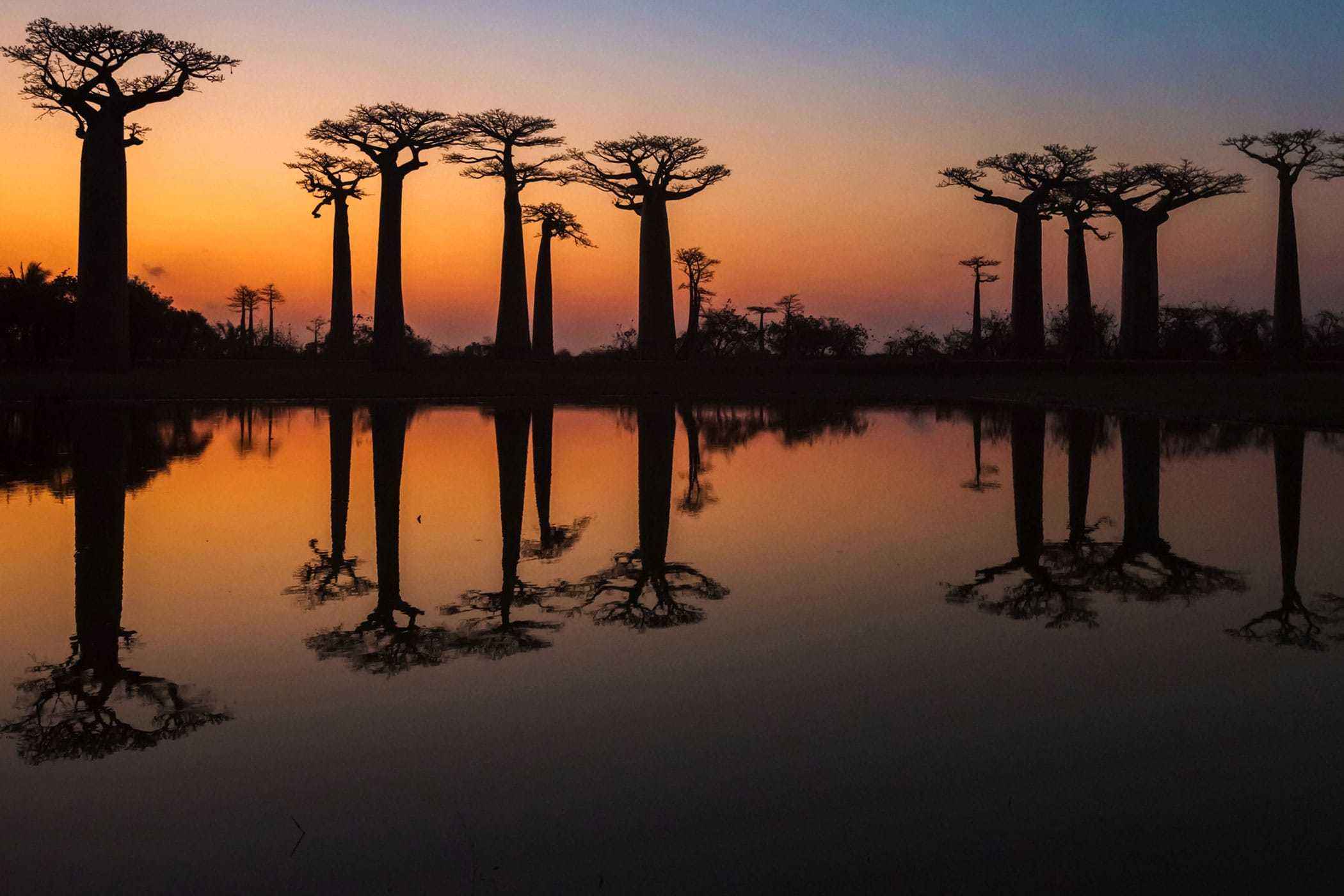- ⁄
- Travel News
- ⁄
- Outdoors •
- Trip Ideas
From evergreen giants to bulbous oddities, here is our roundup of the most amazing trees on the planet.
Trees are amazing. We walk amongst them and climb them, and they are the subject of countless folk tales and legends. Trees have kept us warm and provided us with shelter for millennia. They give us sustenance and medicine. Many trees outlive us by centuries, and many have stood as silent witnesses to generations of history. Trees are astonishing in their variety.
Top Picks for You
Socotra Dragon's Blood Tree (Dracaena cinnabari)
WHERE: Socotra, Yemen
Designated a UNESCO World Heritage Site, Socotra is an isolated archipelago that lies 240 miles off the coast of Yemen. Many of the plants that grow on the islands are not found anywhere else on the planet. The Socotra Dragon´s Blood Tree has a maze of squat branches that are topped with a flat crown of leaves. The tree’s red sap gives rise to its name and has been used to make dyes and medicines for centuries.
INSIDER TIPIf you make the trip to Socotra, don´t miss the native Adenium socotranum, a sub-species of the Desert Rose Tree. This surreal oddity has a bulging base and pink blooms.
The Monkey Puzzle Tree (Araucaria araucana)
WHERE: Chile
The Monkey Puzzle has spiky, triangular needles that spiral around its branches, making climbing this evergreen giant a daunting prospect for monkeys and humans alike. The Monkey Puzzle is native to the Andes and is especially widespread across central and southern Chile, where it was declared a natural monument. This prickly puzzler was a favorite with 18th-century plant collectors, who brought seeds and young plants back to the US and Europe. Whilst Monkey Puzzles can be found in many private and public gardens, seeing this majestic tree in its natural habitat is an entirely different experience.
Recommended Fodor’s Video
Baobab (Adansonia)
WHERE: Madagascar
The bulbous trunks of Baobabs are topped with branches that look like root systems—hence their nickname, upside-down trees. Local legends abound as to how this tree got its odd appearance. Did an angry god throw it out of paradise? Was it planted upside down to stop it walking around? This bountiful tree is used in the production of everything from antioxidants to ice cream, and it is found in parts of Africa, Australia, and the Arabian Peninsula. However, Madagascar is the standout destination for lovers of the barrel-bellied Baobab. There are nine different species of Baobab and six can be found on the island, which is also home to the famous “Avenue of the Baobabs.”
The Wisteria Tunnel
WHERE: Japan
Wisteria´s pendulous purple and rose flowerheads can hang to a length of one meter. Native species are found in parts of the US and Asia, but this woody climber is widely cultivated across the planet. It is a member of the pea family and can be grown as a tree or trained up walls. Such horticultural flexibility is taken to an imaginative extreme in Kawachi Fujien Garden in Kitakyushu, Japan. Here, Wisteria have been trained over arches, allowing the blooms to drop down into enchanting tunnels. The garden is open during the flowering season (late April and May). Don´t miss the viewpoint, where you can look down onto a vast and colorful canopy of Wisteria.
The Silk Floss Tree (Ceiba speciose)
WHERE: South America
The green trunks of these South American natives are adorned with conical spikes. The barbed protuberances contrast with the tree´s delicate pink flowers, and the Silk Floss Tree is stunning in bloom. The cotton found inside its seed pods was traditionally used to stuff pillows and mattresses. Like the Baobab, the Silk Floss may have a swollen, belly-like trunk, and its Spanish nickname is palo borracho or “drunk stick.” The Silk Floss Tree´s aesthetic charms have been exploited by city planners, and you can see it lining boulevards in warmer climes across the planet. To encounter this beauty in the wild, take a trip into the tropical forests.
Ancient English Yews (Taxus baccata)
WHERE: England
Twisted and gnarly, Ancient English Yew trees may not have the visual appeal of other amazing trees. Rather, their allure lies in their longevity and the mythologies which surround them. According to the Ancient Yew Group in England, some specimens are over 1,000 years old. Since Druidic days, Yews have been associated with rebirth and eternity, and they were later adopted by Christianity as a symbol of resurrection. Ancient English Yews are commonly found in churchyards, where they watch over centuries-old gravestones. Despite symbolizing eternity, munching on too many Ancient English Yew leaves can be deadly to humans.
The Meikleour Beech (Fagus sylvatica)
WHERE: Scotland
Standing 100 feet tall, this Scottish behemoth is recognized in the Guinness Book of Records as the Highest Hedge in the World. The Meikleour Beech Hedge stretches along a roadside near Blairgowrie in Perthshire. The hedge was planted in 1745, the year of the Jacobite Rising in Scotland. The story goes that the men who planted the hedge went to fight in the Rising, never to return. The hedge was left to grow in their memory.
INSIDER TIPFrom Scotland, you can take a ferry to Northern Ireland and encounter more amazing beech trees, like the 18th century Dark Hedges of Ballymoney, which appear in ‘Game of Thrones’.
California Redwoods (Sequoia sempervirens)
WHERE: Northern California
These much-loved giants can reach a staggering height of 300 feet and may be up to 20 feet wide. California Redwoods suck moisture from the sea fog that creeps along the Californian coast. They absorb the water through their needles, a far more efficient system than pumping it up hundreds of feet from the ground below. Redwoods can be seen along the coast of northern California and Oregon, but the top viewing spot is the famous Avenue of Giants, a 31-mile long stretch of road that runs through Humboldt Redwoods State Park.
The Tule Tree (El Árbol del Tule)
WHERE: Mexico
This sprawling Montezuma Cypress (also known at the widest tree on the planet) stands in a churchyard in Santa Maria del Tule near Oaxaca. Precisely measuring and dating the Tule Tree is tricky, but the tree´s circumference is believed to be between 140 and 160 feet, giving rise to the claim that it is the widest tree on the planet. Estimates of its age vary from 2,000-3,000 years. What is not in doubt, however, is that this is a very wide and very old tree. Over time, the Tule Tree’s ancient trunk has been twisted into strange patterns and shapes, which have been named after animals. Look out for The Jaguar or The Elephant.
The Walking Palm (Socratea exorrhiza)
WHERE: Central and South America
It is said that this perambulating palm strolls through the rainforest at a rate of 20 meters a year. The Walking Palm’s elaborate stilt-root system extends from the lower part of its trunk down into the forest floor, giving the appearance of a tangle of legs. However, there has been much debate as to whether or not it does in fact “walk.” Costa Rican biologist and Walking Palm expert, Gerardo Avalos, has concluded that the popular belief is a myth. The tree´s roots are firmly embedded in the ground, he says. Nevertheless, this Triffid-like jungle dweller continues to delight.




